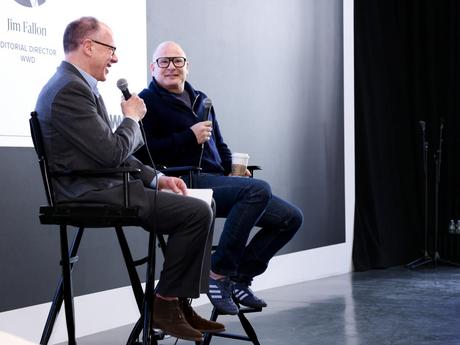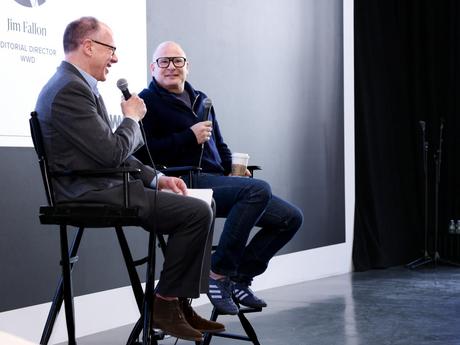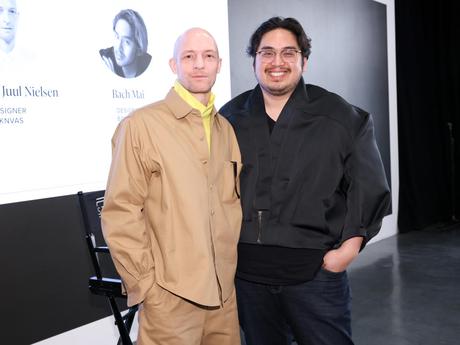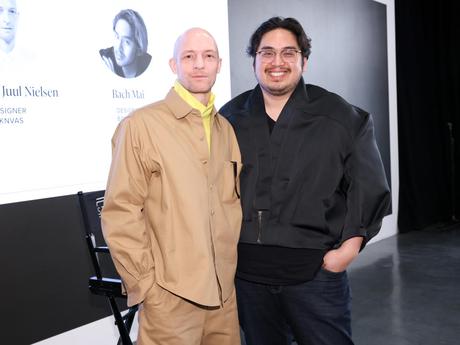
Ahead of the Fashion Scholarship Fund's annual evening gala, WWD invited students to get an early start in the studio with a variety of panel discussions designed to teach the incoming class about the fashion industry. The new class of FSF scholars consists of 130 students recognized for their talents and potential to disrupt and transform the fashion industry.
James Fallon, editor-in-chief of Fairchild Media Group, kicked off the day's programming with a session called "Daily Edit Meeting." "The newsroom is a controlled anarchy," he told the group of FSF finalists.
More from WWDFallon spoke about WWD's importance in maintaining a tight and trusted group of executives, CEOs and designers in its groundbreaking reporting and daily breaking industry news.
Although sources often push for designers' departures or major industry shakeups one way or another, Fallon explained that WWD does not cover every rumor that lands on its wide variety of reporting agencies, as this would compromise the integrity of the publication undermine. "The foundation of what we do is objective reporting," Fallon said. "Fashion loves gossip."
Furthermore, Fallon warned of the dangers of artificial intelligence as a substitute for good journalism. He compared ChatGPT and other prominent software to Wikipedia, explaining that technology can never truly take over the role of a journalist and the relationships a publication has built over the years.
The session ended with advice for aspiring designers. Fallon cited longevity and having a unique vision with a solid business as an important key to success; he warned about designers who constantly follow trends and have no brand identity.


Immediately afterwards, American fashion designer Reed Krakoff joined Fallon on stage to share the story of his career. Looking back on the very beginning of his entry into fashion, Krakoff said it was completely organic. Fashion had not yet become big business, with very few public companies. Only after trying a few different paths did Krakoff land at Parsons, feel comfortable within the industry and begin working with designers including Ralph Lauren.
The story continues
Krakoff explained that he has learned a lot from the experience he has gained throughout his career, including how to understand a brand. Krakoff then teamed up with Tommy Hilfiger, where he worked on launching 10 new categories. But Hilfiger ultimately fired him because Krakoff was getting a little too big for his britches. He had been unemployed for about a year and had taken a job with Trussardi in Milan. But Coach called him and urged him to meet with CEO Lew Frankfort, who convinced him to join in and change the brand. Krakoff turned it into a megabrand that expanded beyond a handbag to include other accessories and fashion.
In 2010, Krakoff launched an eponymous brand under Coach. The company had success dressing Michelle Obama for her official portrait as first lady and a cover of Vogue, as well as Jennifer Lopez - but the designer said it ultimately wasn't enough. Krakoff went to his partners and asked them to make a major investment or the brand would have to end. "It was very sad, but I knew this just wasn't my destiny," Krakoff said.
After the Reed Krakoff brand closed, he became Chief Artistic Officer at Tiffany & Co. before joining L Catterton as strategic advisor and creative chairman of the John Hardy subsidiary. When asked if he is now seen as the turnaround specialist for brands, Krakoff agreed, saying his role is to "make people uncomfortable." He reflected that he believes that to be successful you have to challenge yourself and go through periods of uncertainty. Brands that fall into the trap of pretending they're just selling products, he says, lose credibility and customers. "You have to bet on newness, bet on a new vision."
Christian Juul Nielsen, designer at Aknvas, then sat down with Bach Mai, designer at his eponymous brand, to give the students advice about starting their own brand.
A Danish designer, Nielsen studied at the London College of Fashion and moved to Paris, where he worked at Nina Ricci, Christian Lacroix and Christian Dior under John Galliano and Raf Simons. Meanwhile, Texas-born Mai attended FIT and later moved to Paris to earn his master's degree at the Institut Français de la Mode; Mai worked at Prabal Gurung, Oscar de la Renta and at Maison Margiela under Galliano.
Both Nielsen and Mai worked in Paris on haute couture worth hundreds of thousands of dollars, but considered the clothes unapproachable to most people. Nielsen said his approach to his brand is to "bring couture to the street and add couture-inspired details," while working in similar ways to his time in Parisian couture houses.
Mai said that as an American, Paris was always a distant dream. After returning to the US, he wanted to study couture with an American approach, explore his Texas background and the future of American couture. Mai said other major event designers in the industry include fellow Texans such as Daniel Roseberry at Schiaparelli, Brandon Maxwell and Jackson Wiederhoeft.
Nielsen explained how image curation is a fundamental part of the fashion world, especially given today's social media and digitally driven era. Mai and Nielsen both explained that they had initially forgone a runway show and used lookbooks and presentation formats, mainly because the costs of staging a show are exponential. But Nielsen encouraged designers to stay spontaneous and cast their friends as models and use their school connections to bring their brand to life.
While Nielsen said he finds it impossible to plan ten years ahead. He suggested starting at least three seasons ahead with a loose plan while encouraging aspiring designers to find their niche and who their audience is. Mai similarly stated that designers should ask themselves "why do these clothes need to exist?" in the larger fashion ecosystem, rather than as a self-indulgent endeavor.
Mai quoted Tom Ford's famous quote about how he is fortunate to spend "10 percent of the time designing," while most of the time he spends running the business is related to entrepreneurship. Mai went on to explain that the fashion industry is incredibly difficult and it is crucial to figure out where to find the money to finance the business.
Mai gave the students one last piece of advice: "You don't have to compete with these big brands, and don't try to. You have something different to offer."


The day concluded with Emily Mercer, market editor at WWD, and Thomas Waller, senior fashion market editor for accessories at WWD, sharing their own insights behind the making of a WWD cover. Mercer and Waller explained that unlike many other publications, their role as market editors at WWD is not only responsible for editorial fashion shoots, but also writing fashion show reviews, fashion week coverage and writing weekly news or feature stories. They agreed that this role requires complete immersion, from meeting with the brand's PR agencies to connecting with emerging designers.
"On a normal day, you might wake up in the morning and see a CEO for an interview," says Waller. "[And then] someone sent me a DM from a young brand in Brooklyn this weekend asking to be seen. Maybe we're having dinner that night and you're excited to have dinner with Gucci - and that's cool - but what that really is is a time to build relationships and meet people in the industry.
To prepare for a photo shoot with celebrities or models, Mercer explained that it is a collaborative experience between the visual team, the art team, the writers and the fashion team, where the style director will typically lead the overall idea with the visual director and conceptualize. . "From there we go to market and determine what will be seen on set in terms of fashion," she said.
Relationships and collaboration, Mercer and Waller agreed, are among the most important aspects of their work. Before a photo shoot, the fashion team works together to create direction, what to see and what story to tell. During a photo shoot, no task is too small for anyone on set.
The best of WWD